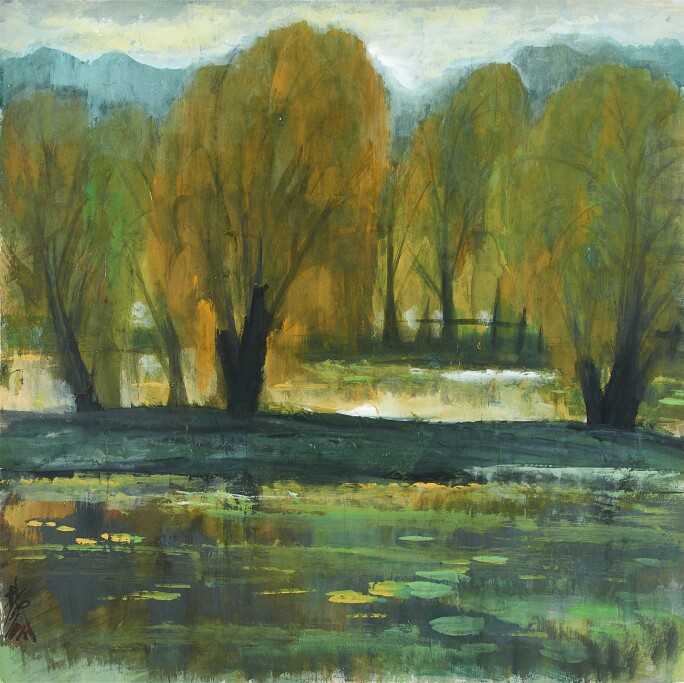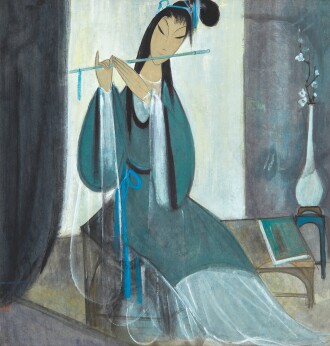"A poet cannot help being influenced, therefore he should subject himself to as many influences as possible, in order to escape from any one influence."
I t might at first seem surprising to use the words of an American-English poet in an introduction to Lin Fengmian (1900-1991), but they work well to describe the pioneering Chinese modern artist who lived and painted with an openness to influence that T.S. Eliot himself would have admired. Throughout his long and productive life, Lin absorbed diverse influences, hybridizing a wide array of stylistic approaches into his expressive paintings. He was one of the first Chinese artists to make a serious study of European modern art while also looking carefully at the Song dynasty (960–1279) landscape paintings and ceramics. He saw no contradiction in this coexistence – Eastern, Western, ancient and modern influences all commingling in a single work of art.
An Unconventional Chinese Artist Open to All Influences


Lin's open-mindedness was a kind of curse as it often brought the artist into conflict with authorities and institutions who served as guardians of acceptable culture. Eventually Lin’s broad interests and independent convictions helped him transcend limits the limits of place and politics. Lin who served as the director of the National Academy of Art in Hangzhou (now China Academy of Art) is regarded as an important educator and one of China’s most original early modernists. He is also respected as an early exponent of Expressionism, a European style that shared the inwardness of some Chinese literati and individualist scroll paintings.
After spending several years in Europe in the early 1920s, where he was enchanted by French and German art, Lin returned to China in 1926 as a prophet of modernism. As an educator – among whose students included Zao Wou-ki, Chu Teh-Chun, and Wu Guanzhong – Lin was sympathetic to the views of Liu Haisu (1896-1994), the founding director of the Shanghai Art Academy. Both played an important role in modernizing art education at a national level, and their pioneering efforts changed the course of modern art in China.
“…we want to fulfill our responsibility of promoting art in a society that is callous, apathetic, desiccated, and decaying. We shall work for the rejuvenation of Chinese art, because we believe art can save present-day Chinese society from confusion and arouse the general public from their dreams.”
Looking at Lin’s art is best done with the same kind of open-mindedness that he brought to teaching and art making. Seen alongside works by some of the artists whose works he absorbed and admired helps to expose the remarkable vitality and hybridity that Lin was able to generate.
Portrait of a Lady
The Influence of Matisse & Modigliani
Lin’s Lady by a Vase and Lady Playing Pipa shows the influence of two artists that Lin encountered in Paris: Henri Matisse and Amadeo Modigliani. Matisse’s numerous paintings of ladies in interiors—with their sensitive brushwork and decorative motifs—must have enchanted Lin. The mask like features of Modigliani’s portraits, derived from Etruscan carvings, clearly had an impact as well. The square format of Lady by a Vase and Lady Playing Pipa, which puzzled some Asian viewers accustomed to the horizontal and vertical expanses of paintings on scrolls, had once been popular during the Song dynasty (960–1279).

middle: LIN FENGMIAN, LADY BY A VASE , Lod Sold 2,400,000 HKD
right: Amedeo Modigliani, PAULETTE JOURDAIN , circa 1919, LOT SOLD. 42,810,000 USD
Chinese Opera
Visual Rhythm of Cubism, Post-Impressionism
In the many paintings Lin did of Chinese Opera he used figures to compose dynamic, colorful paintings that feature visual rhythms and shallow spaces that show the influence of Cubism. Semi-transparent areas of fabric show that Lin was understood the technical possibilities of oil paint while the fluidity of his brushwork connects to the artist’s early training in calligraphy and ink painting. The paintings exude a freshness that Lin was able to achieve by hybridizing influences and methods. The bold colors of Impressionist and Post-Impressionist art, including blues and yellows made possible by new pigments developed in the late 19th century, are an important part of Lin’s aesthetic.

Lotus Pond
Variations of Light in Monet's Water Lilies
The high horizon line and all-over composition of Lin’s Lotus Pond at Dusk brings to mind Claude Monet’s numerous canvases of water lilies. Monet painted more than 250 Nymphéas (Water Lilies), some of which Lin must have seen in Paris. Like Monet’s Nymphéas Lin’s painting uses the lotus as a motif to explore the variations in colour and light made possible by floating forms. The tall, calligraphic silhouettes of swaying reeds, which form a band at the top of Lin’s composition, are set off by softly brushed banks of clouds.

right: Claude Monet, NYMPHÉAS , 1908, LOT SOLD. 23,731,624 GBP
Landscapes
Expressions of Land and Sea

The stormy sea that appears in Lin’s Cormorants by the Fishing Boats demonstrates his interest in the realistic depiction of weather, a favorite subject of the French Impressionists. Adapting oil painting techniques to depict rhythmic rows of translucent waves in pastel, Lin creates a turbulent mood set off by a looming grey clouds. The play of light between the somber shades of blue and grey of the water and the sky creates a sense of distance and depth.

right: Claude Monet, VUE D'ARGENTEUIL , 1872, LOT SOLD. 1,428,500 EUR
Flower Paintings
Fantin-Latour: Still Life as Portrait of the Artist

The sensitively brushed flowers in Lin’s Vase of Flowers express the quiet, contemplative aspect of the artist’s nature. Lit from behind by a halo of yellow and tilted slightly towards the viewer, the Vase of Flowers feels modern while also emanating Taoist virtues including a certain refined simplicity. Like the floral paintings of the French artist Henri Fantin-Latour, Lin’s Vase of Flowers can be viewed as a kind of portrait of the artist’s mood and inner life.

right: Henri Fantin-Latour, Fleurs (Pensées) , 1883
Lonely Wild Geese
Returning to Calligraphic Brushwork

Viewing Lin Fengmian’s ink paintings offers an understanding of the roots of his art in traditional Chinese painting. Geese Flying Over Reed Pond, which has a monochromatic palette of white, grey and black, uses calligraphic brushwork to depict flying geese and reeds bending in the wind as well as a European style scumble (rough brushwork) effect in the clouds. The scene was inspired by both the great Tang dynasty poet Du Fu's "A Long Climb" and the artist’s own memories of West Lake, Hangzhou.
"In a sharp gale from the wide sky apes are whimpering, birds are flying homeward over the clear lake and white sand."
The Three Musketeers
Zao Wou-Ki, Chu Teh-Chun & Wu Guanzhong

Lin Fengmian loved painting birds, which reminded him of his childhood memories of playing in the forest, connected with nature. Blackbirds, often placed on large branches, are common in Lin’s works. The Three Musketeers is a rare work because of its blank background and striking contrasts of dark and light. Drawn with swift, energetic strokes the birds suggest innocence and camaraderie. Interestingly, the work may allude to Zao Wou-Ki, Chu Teh-Chun, and Wu Guanzhong, three students of Lin Fengmian who are often referred to as “The Three Musketeers of Chinese Modern Art.” Like Lin Fengmian, these great artists all were influenced by their exposure to Paris and European modern art.





